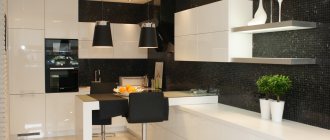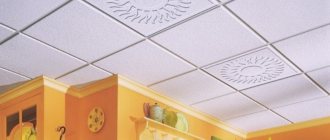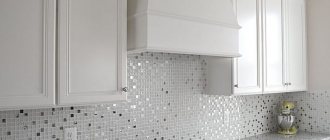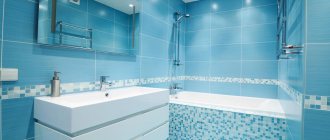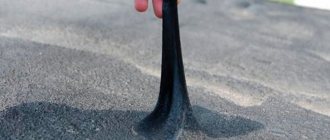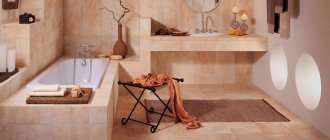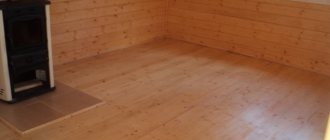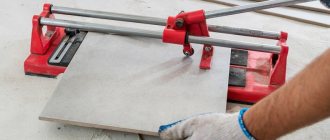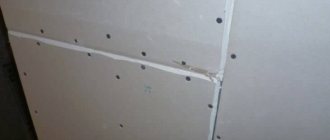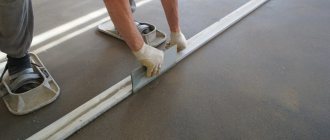Everyone who has done renovations has faced the problem of how to choose tiles for the kitchen floor. Finishing the kitchen floor with ceramics - a successful option from both an aesthetic and environmental point of view, and also has operational characteristics. The design of kitchen floor tiles plays a key role in interior design: it supports the style and color scheme of kitchen furniture, wall cladding and decorative elements. By choosing a beautiful floor covering with excellent strength properties, you will give your kitchen interior an impressive look for many years to come.
The first mistake. The budget is bursting at the seams!
Having studied the range and prices of tiles, we naively believed that tiles were no more expensive than good linoleum. Having bought 3 packages of tiles and 3 bags of tile adhesive (one bag per 3 sq.m.), we thought that the big expenses were over.
But it was not there! During two weeks of repair work, we visited the store four more times. I had to buy another package of tiles and double the amount of glue. But the most unexpected expense is the tool. The tiles needed to be cut and leveled with something! So, I had to purchase a tile cutter and an attachment for an angle grinder. By the way, it didn’t work the first time. It has been established by trial and error that an angle grinder requires a disc with a special attachment socket; other options lead to the separation of small fragments from the tiles in completely inappropriate places. Of course, I really needed a level, but a rubber hammer, bought on the advice of the seller, helped little.
We bought a regular iron spatula with a smooth edge. Already at home, having realized their mistake, they modernized it: taking a grinder with a metal disc, they cut out neat teeth on the spatula blade. As it turned out, it’s a very convenient tool!
Having stocked up on tools, we decided that we were no longer in danger of spending.
The idea of skirting boards came a little later; not leaving the old wooden skirting boards would mean, again, expenses. By the way, there was absolutely no hassle with them: they fell into place within an hour. Thanks to those who invented plastic skirting boards!
Grout options
There is a special mixture for decorating seams, which can be applied in several ways:
- choose a color to match the coating to completely hide the seams;
- emphasize the geometric pattern using contrast (black tiles - white stripes);
- use a clear mixture. Suitable for surfaces with an ornamental pattern, a special play of colors, or a variegated pattern.
If there is high humidity in a house or apartment, it is recommended to use epoxy grout. It prevents the appearance of black mold and mildew and is impervious to moisture. This option is more expensive, but will eliminate problems with dampness.
Error two. We refuse the screed. But in vain...
Everyone knows that a good renovation begins with the owners packing up their things and leaving the apartment. Since we had nowhere to leave and wanted to use the kitchen every day, it was decided to abandon the screed, and the desire to cut costs did its job. We took out the furniture, but the slab was supposed to be moved “back and forth” on a long flexible hose as the pieces of the laid floor dried. It was thought that concrete screed was a too inconvenient procedure: the hassle of turning off the stove, several days of complete absence of a kitchen, etc.
The concrete floor slab seemed completely flat, and the level showed that the height difference from the window to the threshold was no more than 1-2 cm, although as it turned out later it was about 3 centimeters.
They started work with enthusiasm: they drilled holes in two opposite corners, screwed in self-tapping screws, pulled a rope, mixed glue and started laying tiles strictly from the corner: diagonally, not forgetting to insert a pair of crosses between the tiles on each side. Most of the time was spent working with the level. The first tiles had to be torn off and glue added to the right places: the tiles “danced” and did not want to align, even under the blows of a rubber hammer. I managed to gain experience and spend “only” 10-15 minutes on laying one tile only by the beginning of the second pack.
During the first day we laid a little less than 2 km.m. and left them to dry for a couple of days so that there would be somewhere to move the gas stove. In total, the “kitchen floor” operation lasted two weeks.
The fact that the screed was completely in vain became clear after 3 days. As you move from the window to the door, it takes more and more glue to lay the tiles evenly. We laid out the last tiles like this: for 3 tiles - 25 kg. dry glue despite the fact that manufacturers recommend this volume for 3 square meters. m! Yes, I’ll tell you frankly, leveling the floor with tile adhesive is tedious and annoying.
Care
Proper installation will not ensure longevity of kitchen tiles if its surface is not taken care of.
- glossy material cannot be cleaned with a wire brush or abrasives;
- greasy stains can be easily removed with vinegar dissolved in water;
- wax mastic and various hydrophobic agents will help create a protective layer on the surface and prevent the accumulation of dirt;
- The water for cleaning tile floors should be warm or hot.
At the dry cleaning stage, the surface covered with ceramic tiles is vacuumed or swept with a soft brush to remove sand particles and large debris. Then use a napkin with a suitable detergent to remove dirt in a circular motion, rinse the floor with clean warm water, removing any remaining soap solution.
Ceramic tiles are the leader among finishing materials for kitchen floors. But it is recommended to buy this product in trusted places, and give preference to well-known brands with a worldwide reputation.
Error three. We violate safety regulations and despise labor protection.
What's the most tedious and uninteresting part about laying tiles? That's right, mixing the glue. As it turned out, this is also a very unsafe activity.
After a couple of days of working with this mortar, we felt something was wrong: my hands turned red and itchy, and a severe runny nose began, my eyes turned red and watery. Attributing my malaise to the spring “flu” season, I stubbornly continued to knead the tile adhesive solution with my hands (!), since, of course, we did not have a special electric mixer, and the home mixer could not cope with such volumes.
A neighbor-doctor who dropped by to visit made the diagnosis a week after the work began. Allergy. It turns out that additives in tile adhesive are extremely harmful to the skin and mucous membranes. Our work impulse was crowned with the joint use of Tavegil, the purchase of a respirator, rubber gloves and a break for a couple of days to restore lost health.
The following labor safety violations relate to working with an angle grinder. And we are not talking about the banal danger of getting hurt. When cutting tiles, you should be very careful, because small particles sooner or later get into your eyes, and breathing tile dust is a dubious pleasure. A respirator is an irreplaceable thing in this case.
Laminate
Another analogue of natural wood has become a full replacement for older design options.
Material:
- You can install it yourself without the help of complex tools;
- It has the colors of stone, wood, sand, leather, mosaic;
- Has an attractive structure and warmth;
- It withstands moisture well when using a moisture- and water-resistant coating.
The disadvantage will be:
- Sensitivity to chemical reagents;
- Low resistance to falling sharp or heavy objects;
- The sonority of the finish.
Error four. Where did the fourth package go?
Experience is an expensive thing. In this case, it cost me about one and a half thousand rubles. This is the money that was spent on additional packaging of tiles and bags of glue. If everything is clear with the glue - it replaced the cement screed, leveling the plane of the floor, then with the tiles it was a different story.
We crushed a couple of tiles in the process of fussy moving in the narrow space of the corridor. But another 8 pieces were used “for training”. The fact is that by choosing a diagonal styling pattern, we found ourselves an adventure. Along the edges it was necessary to lay the corners of the tiles, that is, cut them diagonally. Cutting tiles is not that easy. The tile cutter broke our tiles like a child breaking a melted chocolate bar. He stubbornly refused to punch a hole with a diameter of 8 cm in a solid tile for a pipe until he ruined half the package.
Unsuitable coatings
There are quite a lot of floor design options, and choosing the most suitable covering is quite difficult. But we can safely recommend walking proudly past the carpet.
This material:
- Gets dirty quickly;
- Requires complex care;
- Flammable
Parquet and parquet boards, which do not tolerate changes in humidity and temperature changes, will not feel very good.
If you still want to decorate the kitchen as gently and beautifully as possible, then these sensitive materials are transferred to the dining area.
Error five. The seams do not forgive negligence.
The joy of the smooth, beautiful floor quickly turned into despondency. We missed a little thing: seams. We left the seams shallow (we thought it was better that way), and we gave them a long time to dry. And when the last tile was laid, it suddenly became clear that the seams needed to be cleaned in order to fill them with high-quality grout. I had to clean the seams with a screwdriver and a hammer; the corner joints were especially difficult. I confess that small chips appeared in several places as a result of my manipulations. The cleaning took almost two days and only then my daughter and I, having thoroughly wet the seams, began to rub them down. No gray grout was found in the store. I had to buy white and add gray universal tinting paste. It was difficult to guess with the shade, now the difference in the color of the seams is a feature of our floor.
Colored tiles for the kitchen: which shade to choose
When choosing tiles for the kitchen floor, you need to think about which color will be more suitable and practical. A white floor in the kitchen is an excellent solution: a light-colored coating visually expands the space and looks organic in rooms of different sizes. White color may seem dirty and impractical only at first glance: in fact, it shows fewer water marks and prints of bare feet. The same cannot be said about black tiles. As practice shows, a dark coating is an excellent choice only if your interior is perfectly clean.
Project author: Nadezhda Shtrymova
Project author: Nadezhda Shtrymova
Project author: Natalya Dashkova
Project author: Natalya Dashkova
The most versatile shades for kitchen floors are gray and beige tones. They are suitable for both classic and modern interiors and do not require special care or use.
Project author: Tatyana Snezhkina
Project author: Tatyana Snezhkina
Dimensions and format
The optimal format of floor tiles for a particular kitchen depends on its area and layout. If the floors are small in area, then preference is usually given to small formats: up to 60x60 cm. If the kitchen is spacious or adjacent to the living room or dining room, it becomes possible to lay the floors with large-format tiles in order to minimize the number of seams.
Cork covering
Natural cork has many positive qualities. She:
- Eco-friendly;
- Pleasant to the touch;
- Maintains optimal temperature regardless of the ambient air condition;
- Not afraid of water, shock, insects.
Mold does not form under it, and the springy material is perfect for people with bad backs and children who constantly fall.
The disadvantage will be the high price of the material.
Self-leveling floor
Liquid linoleum has all the advantages of its ancestor and makes it possible to turn the kitchen floor into a forest clearing, a river bank, a meadow.
The only disadvantage will be the high cost of the material itself, the requirement for perfect alignment and the complexity of installation.
Combination of different textures
In a large room, the floor can be decorated using several options. To decorate the working area, tiles, porcelain stoneware, and linoleum are used; Wood and its imitations and cork are installed in the dining area. This will help to furnish the kitchen as warmly, beautifully, reliably and durable as possible.
Concrete
The concrete base looks solid and solid, but it is not very convenient to use due to the coldness of the coating and its peculiar appearance. Most often, this coating decorates Loft-style kitchens.
The advantages of this design are:
- Wear resistance;
- Strength;
- Durability;
- Resistance to all negative climate changes and chemicals.
